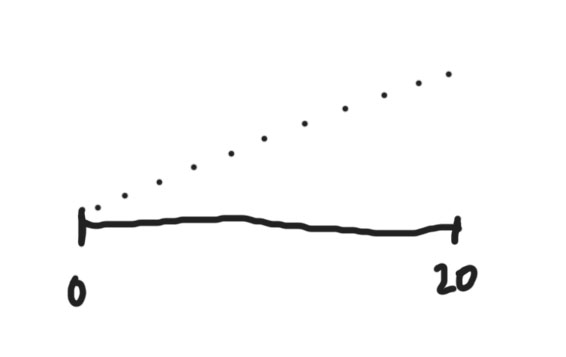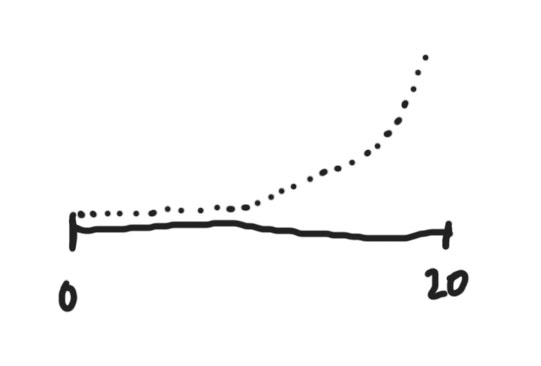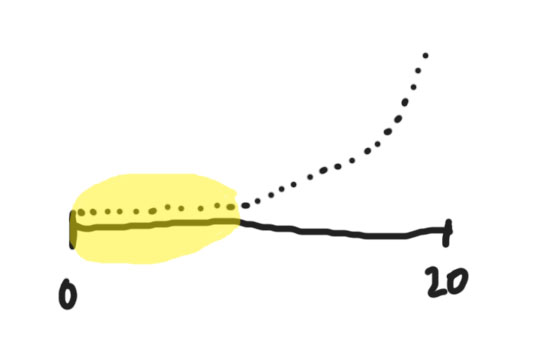You have what little muscle you have (HONESTY IS THE BEST POLICY OR SO I HEAR) thanks to gravity. If you want to be more muscular, you need to hop into a hyperbolic time chamber and overcome supergravity. In other words, you need to create and move against more resistance than what Earth’s gravity already provides. [...]
You have what little muscle you have (HONESTY IS THE BEST POLICY OR SO I HEAR) thanks to gravity. If you want to be more muscular, you need to hop into a hyperbolic time chamber and overcome supergravity.
In other words, you need to create and move against more resistance than what Earth’s gravity already provides. Wrote about this in Part 2. I’ll add to it in the future, but you’re sitting pretty now because you know enough to face the question at hand:
How much resistance (weight) do you have to move (lift) in order to build muscle?
I could be blunt.
Likely, at minimum, 60% of your one-repetition max (1RM). Or, if numbers scare you (or you’re using a form of resistance no easily as quantifiable), just think: sticky movements.
But, well, you know me. I like to explain things, which is why I’m going to undo my bluntness and dive into the deep. If my blunt answers weren’t enough (or were confusing), you’re welcome to suffer along with me.
The RPG analogy to end all analogies (or my sanity, haven’t decided)
Imagine that you’re a character in an RPG. Your ability to overcome load (definition established in Part 2) exists on a spectrum that goes from Level 0 to Level 99.

When you’re Level 1, you can barely overcome Earth’s gravity. Level 99 represents your biological ceiling; the maximum load you’ve ever be able to overcome.
(You aren’t at your biological ceiling. Even the greatest athletes in the world improve slightly from year to year. Don’t worked up about where you are in relation to your ceiling. You just need to know that one exists.)
For gits and shiggles, let’s assume you’re Level 20. (You’re obviously not Level 1. If you were, you wouldn’t be able to move.) With this Level, and every Level, comes certain realities dictated by the rules of the RPG.
First, you have a magic spell for every Level. So you have a Level 1 magic spell, a Level 2 magic spell, a Level 3… all the way up to Level 20.
Second, your maximum magic capacity is your Level. Since you’re Level 20, you have 20 magic points available.
Third, each spell uses an amount of magic commensurate with its Level. If you use a Level 5 spell, you use 5 magic points.
Fourth, after you use a magic spell, your magic points slowly regenerate over time.
Fifth, the higher Level you are — the more robust and powerful you are — the more resources it takes to keep yourself afloat. You have more everything so you need more everything to accommodate for said everything.
If you aren’t a video game nerd, the above analogy won’t stick well. Sorry I’m not sorry. Consider this the wedgie you always deserved but never got.
How your spells influence you
You’re Level 20. You use your Level 1 magic spell. It only requires 1 magic point. Considering you have 20 magic points available, the overall impact on you isn’t huge. You still have 19 points available.
But say you use a Level 18 spell. You now only have 2 magic points left, which means the overall impact on you is huge. The fact that you only have 2 magic points left makes you vulnerable. Even a peon enemy can beat you because you can’t use stronger spells (until you recover).
So a Level 18 spell is stressful on a Level 20 character. It’s stressful from a resource standpoint (it uses up a lot of magic points relative to your overall capacity). It’s also stressful from an impact standpoint (after you use it, you’re vulnerable because you can’t use higher spells).
You are a moist machine
The not so general rule of thumb: higher Level spells are more stressful than lower Level spells — an important factoid because your body isn’t a huge fan of stress. Your body is a much bigger fan of stasis, which is to say: equilibrium and balance. When you’re stressed, your survival is compromised.
So say you’re Level 20. You constantly find yourself throwing Level 15 spells. In other words, you’re undergoing chronic stress. You’re always in a weakened state.
If your body were a regular machine, the only thing it’d be able to do is recover and repair as much (and as quickly) as possible in between spells.
Fortunately, your body isn’t a regular machine. Your body is a moist biological machine with… abilities. It can adapt, change, and become a creature better able to survive certain situations. In other words, your body can Level Up.
How to Level Up
When you’re Level 20, throwing Level 15 spells is stressful. But what if you are Level 30? Or Level 40? Throwing those same Level 15 becomes a much less stressful experience.
So if you’re Level 20 and you find yourself going through the chronic charade of throwing Level 15 spells, your body can make a calculated decision to Level Up.
Leveling Up might not seem like a difficult decision to make. Your body doesn’t like to be stressed, and, by Leveling Up, your body won’t be as stressed.
But there are downsides to Leveling Up. Remember, being a higher Level requires more resources. Requiring more resources is also a “vulnerability” because you become less energy efficient. As mentioned, in Part 1, your body doesn’t fuck around when it comes to energy.
The big juicy RPG analogy flaw
If your body is stressed from chronically throwing high Level spells, it can Level Up. This is the nugget nectar, the reason we’re here. But before we eat the nectar, I have to first mention a big juicy flaw in this RPG analogy.
I created the flaw on purpose to make things less complicated, but now it’s time to undo it and make things more complicated.
Initially, I established linear rules for the RPG. Your magic spell uses an amount of magic commensurate with your Level. In other words:
- Level 1 spell uses 1 magic point
- Level 6 spell uses 6 magic points
- Level 18 spell uses 18 magic points
If you plot this out on a graph (magic points vs. Level), you get a nice straight line. One step east takes you one step north. The stress of your spells increases linearly; a Level 2 spell is twice as taxing as a Level 1 spell.

But, in reality, there’s a nonlinearity to stress. In other words, one step to the east won’t always take you one step to the north.
How to break your leg in style
You stand on a one foot high wall and jump off. Then you stand on a two foot high wall and jump off. Then you stand on a three foot high wall and jump off. The idea: the higher the wall, the rougher the landing.
In this sense, it seems that jumping off a wall plays by the same linear rules established five seconds ago. But it doesn’t. Here’s why.
Imagine jumping off a one foot wall twenty times. You can calculate the impact as (ten impacts @ 1 foot = ten feet worth of impact).
Imagine jumping off a ten foot wall one time. You can calculate the impact as (one impact @ ten feet = ten feet worth of impact).
Despite both situations adding up to ten feet worth of impact, you know, intuitively, that each situation is a lot different, which is why you’d rather jump off a one foot wall ten times.
Say hello to my little nonlinear friend
The increased severity that comes with jumping off the ten foot wall is a product of nonlinearity. When you plot nonlinearity on a graph, you end up with a curve instead of a straight line. This curve has an inflection point — a point where the line heads north at a more rapid rate.

Establishing nonlinearity is important because it gives you a more accurate depiction of how stress correlates to certain Level spells.
Earlier, you might have concluded that twenty consecutive Level 1 spells was “equal” to one Level 20 spell. But now, if you overlap this nonlinear curve atop the Level spectrum, you can see that a Level 1 spell might only use fractions of one magic point.
Ceiling versus comfort
The presence of nonlinearity enables a comfort zone on the Level spectrum in relation to your ceiling. (Your ceiling is simply your current Level.) Given your current Level, there’s a cluster of spells you can use regularly without excessive stress baggage.

At some point, however, the comfort zone fizzles, and the spells get exponentially more stressful… which is exactly where you want to be. In case you fell asleep, let me tell you why.
Leveling Up and building muscle
If you want to build muscle, you have to Level Up. Making your body Level Up is the point; muscle mass is a byproduct of Leveling Up.
In order for you to Level Up, you have to throw spells beyond your comfort zone. You have to stress your body, otherwise, you body has no reason to upgrade.
This brings us to the question we’ve been mining from the start. At what point does the comfort zone break down? At what point do the spells become stressful enough to get the body thinking about Leveling Up?
Gravity as an enemy
Time to shift from RPG to reality. Hopefully the transition’ll be smooth. We’re all fighting the same enemy (same load): Earth’s gravity. This is like always fighting a Level 3 enemy.
If we were Level 3, we’d be constantly stressed out bonkers. In order for us to face a Level 3 enemy on the regular, our body has to adapt to a point where a Level 3 enemy is safe and comfortable.
In other words, our ceiling — our real Level — has to be higher than Level 3. When you’re Level 20, Level 3 enemies aren’t a big deal. And that’s what your body wants; your body wants stasis. Balance. Ease.
The, uhh, Nazi salute…?
Take any single movement you can think of. Let’s use the Nazi salute as an example, just because it’s offensive and I was told that offending people would get me more followers.
This Nazi salute, without weight, is a Level 3 spell according to our analogy. In other words, we’re coasting in the comfort zone.
Now, slowly add weight to the movement by the pound. You’re making your hand heavier and heavier. Eventually, you’ll hit a point where you’ll be unable to lift your arm in the air. This weight represents your one-repetition max (1RM) — the amount of weight you can lift one single time.
This 1RM represents your current max Level, which anchors the nonlinear curve. The sweet spot, the point at which you comfort zone fizzles, is somewhere around 60% of your 1RM.
So if you want to build muscle, if you want to stress yourself, you should be lifting at least 60% of your 1RM on a regular basis.
Another analogy!
If you want to build muscle, you need to go beyond your load comfort zone. There’s now a number attached to this concept (60%). Hurrah! Everyone can go home now.
Just kidding.
I’m going to take things one step further and explain something I’ve already explained… a slightly different way. Surprising, right? Who would have expected such a thing?
Me.
I would have expected such a thing.
Because I know me.
Atop this Level spectrum, we can consider yet another spectrum. The SPRING – STICK spectrum. (This will also help establish rules for resistance training methods that aren’t as quantifiable.)
Springing and sticking
You can contract your muscles. You can relax your muscles. In the end, this is what every movement boils down to. But, funnily enough, you can’t move when you’re 100% in either extreme.
- Total relaxation, you can’t move.
- Total contraction, you can’t move.
Overcoming load is a combination of contraction and relaxation, with movement being biased towards an extreme.
CONTRACTION
Contraction based movements are sticky. Grindy. Friction. In order to be sticky, you have to contract. If your car breaks down on the side of the road and you have to push it, chances are you’re going to be all sorts of sticky moving.
RELAXATION
Relaxation based movements are springy. Bouncy. Ballistic. In order to be springy, you have to relax. If I ask you to throw a baseball as far as you can, chances are you’re going to be all sorts of springy moving.
Stick stick sticky
On the Level spectrum, there’s an inherent flow from SPRING to STICK. In other words, the maximum load you’re able to (consciously) overcome is inherently sticky. Consider this your aforementioned 1RM, your ceiling.
As you reduce the load, you become less contraction based. Eventually, you’ll reach a point where you’re able to comfortably relax and spring under a given load.
Surprise, surprise…
This transition from stick to spring is likely somewhere around 60% of your 1RM.
In other words, if wondering how much resistance you need to overcome in order to build muscle and you don’t want to drown in calculus, simply ask yourself: are you performing an honest sticky movement?
Honest sticky movements
It’s worth qualifying the “honest” adjective I used. Be honest: did you cheat on me? I need to know. Was it me? Was it my fault? I can’t change, baby, but I can sure as hell put on a façade and make it seem like I can (and will) even though I won’t; we’ll be back in the same spot two years from now; it’ll be a recurring loop and we’ll die unhappily ever after.
You decide to walk slow and sticky up the steps, but you could leap and bound quickly up those same steps. So walking up the steps, no matter how you do it, isn’t an “honest” sticky movement.
A good marker to judge honest sticky movements: if you tried your hardest, could you be springy or leave the surface of the earth? If you can’t (to a huge degree, or for a long time), you’re probably in an honest sticky zone.
How to not build muscle
So. Finally. We’ve made it. Muscle growth is a byproduct of Leveling Up. Leveling Up is an adaptation in response to chronic stress. Otherwise said, constantly facing 60% 1RM. Or, constantly overcoming a sticky load.
I realize how lol that last sentence sounds, and it’s a bit too lol for me to care.
But as one door closes, another opens.
You can train at 60% of your 1RM, be sticky as all hell, and struggle to build muscle… for a few reasons. The one I want to tackle next: exercise selection.
There are better and worse exercises. Not surprisingly, a lot of people tend to do the worse ones.
Coming soon…
This is the end of Part 3. Part 4 is in the works. If you want to know when it drops, signup for my weekly email column.
→ Click here to signup
P.S.
I realize there are flaws aplenty within this analogy. My use of “stress” only occurring at 60% of your 1RM is sketchy because it neglects lower load explosive work that can be extremely stressful.